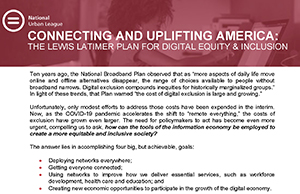Ten years ago, the National Broadband Plan observed that as “more aspects of daily life move online and offline alternatives disappear, the range of choices available to people without broadband narrows. Digital exclusion compounds inequities for historically marginalized groups.” In light of these trends, that Plan warned “the cost of digital exclusion is large and growing.”
Unfortunately, only modest efforts to address those costs have been expended in the interim. Now, as the COVID-19 pandemic accelerates the shift to “remote everything,” the costs of exclusion have grown even larger. The need for policymakers to act has become even more urgent, compelling us to ask, how can the tools of the information economy be employed to create a more equitable and inclusive society?
The answer lies in accomplishing four big, but achievable, goals:
- Deploying networks everywhere;
- Getting everyone connected;
- Using networks to improve how we deliver essential services, such as workforce development, health care and education; and
- Creating new economic opportunities to participate in the growth of the digital economy.
The National Urban League, working with other civil rights organizations and public policy experts, has developed the Lewis Latimer1 Plan for Digital Equity and Inclusion (the “Plan”), a detailed and comprehensive agenda to reach these goals and erase persistent and dangerous gaps.

